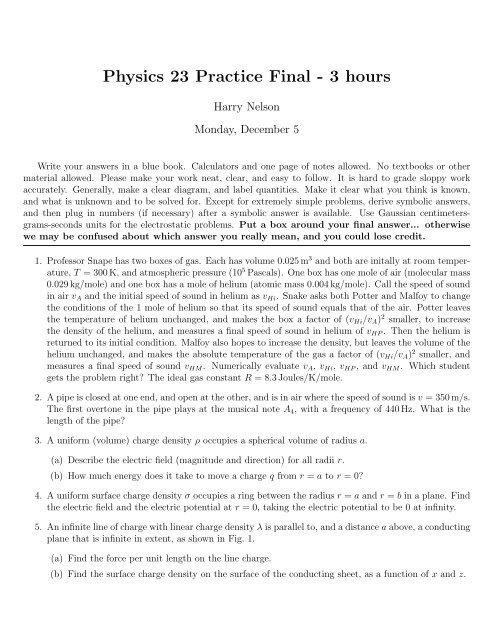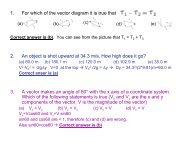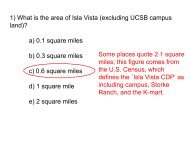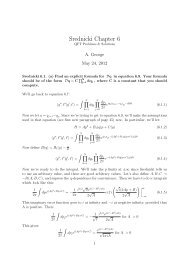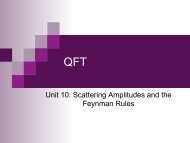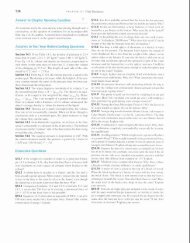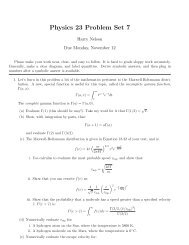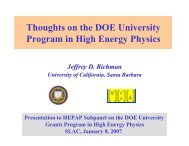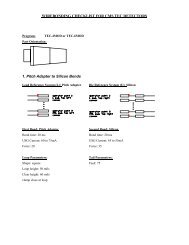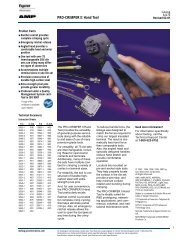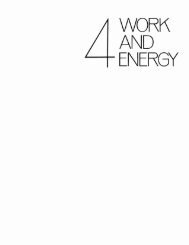Physics 23 Practice Final - 3 hours - UCSB HEP
Physics 23 Practice Final - 3 hours - UCSB HEP
Physics 23 Practice Final - 3 hours - UCSB HEP
- No tags were found...
You also want an ePaper? Increase the reach of your titles
YUMPU automatically turns print PDFs into web optimized ePapers that Google loves.
<strong>Physics</strong> <strong>23</strong> <strong>Practice</strong> <strong>Final</strong> - 3 <strong>hours</strong><br />
Harry Nelson<br />
Monday, December 5<br />
Write your answers in a blue book. Calculators and one page of notes allowed. No textbooks or other<br />
material allowed. Please make your work neat, clear, and easy to follow. It is hard to grade sloppy work<br />
accurately. Generally, make a clear diagram, and label quantities. Make it clear what you think is known,<br />
and what is unknown and to be solved for. Except for extremely simple problems, derive symbolic answers,<br />
and then plug in numbers (if necessary) after a symbolic answer is available. Use Gaussian centimetersgrams-seconds<br />
units for the electrostatic problems. Put a box around your final answer... otherwise<br />
we may be confused about which answer you really mean, and you could lose credit.<br />
1. Professor Snape has two boxes of gas. Each has volume 0.025 m 3 and both are initally at room temperature,<br />
T = 300 K, and atmospheric pressure (10 5 Pascals). One box has one mole of air (molecular mass<br />
0.029 kg/mole) and one box has a mole of helium (atomic mass 0.004 kg/mole). Call the speed of sound<br />
in air v A and the initial speed of sound in helium as v Hi . Snake asks both Potter and Malfoy to change<br />
the conditions of the 1 mole of helium so that its speed of sound equals that of the air. Potter leaves<br />
the temperature of helium unchanged, and makes the box a factor of (v Hi /v A ) 2 smaller, to increase<br />
the density of the helium, and measures a final speed of sound in helium of v HP . Then the helium is<br />
returned to its initial condition. Malfoy also hopes to increase the density, but leaves the volume of the<br />
helium unchanged, and makes the absolute temperature of the gas a factor of (v Hi /v A ) 2 smaller, and<br />
measures a final speed of sound v HM . Numerically evaluate v A , v Hi , v HP , and v HM . Which student<br />
gets the problem right The ideal gas constant R = 8.3 Joules/K/mole.<br />
2. A pipe is closed at one end, and open at the other, and is in air where the speed of sound is v = 350 m/s.<br />
The first overtone in the pipe plays at the musical note A 4 , with a frequency of 440 Hz. What is the<br />
length of the pipe<br />
3. A uniform (volume) charge density ρ occupies a spherical volume of radius a.<br />
(a) Describe the electric field (magnitude and direction) for all radii r.<br />
(b) How much energy does it take to move a charge q from r = a to r = 0<br />
4. A uniform surface charge density σ occupies a ring between the radius r = a and r = b in a plane. Find<br />
the electric field and the electric potential at r = 0, taking the electric potential to be 0 at infinity.<br />
5. An infinite line of charge with linear charge density λ is parallel to, and a distance a above, a conducting<br />
plane that is infinite in extent, as shown in Fig. 1.<br />
(a) Find the force per unit length on the line charge.<br />
(b) Find the surface charge density on the surface of the conducting sheet, as a function of x and z.
Line charge, linear<br />
charge density λ,<br />
extends to ±∞ in z<br />
Conducting Sheet<br />
(extends to ±∞ in x and z)<br />
Figure 1: For use in Problem 5.<br />
6. A person of mass m hangs at rest from a rope attached to a parallel plate capacitor, as shown in Fig. 2.<br />
The rope is attached to a square plate with sides of length L. The square plate is inside a piece of sheet<br />
metal bent into an upside-down U, with a distance 2s between the sides. The plate is in the center of<br />
the bent sheet metal, and the lower edge of the plate is just about to emerge from the bottom of the<br />
bent sheet metal. There is a charge Q on the outside U, and charge −Q on the inner plate.<br />
(a) What minimum value charge Q is required<br />
(b) Numerically evaluate Q in esu for L = 1 m= 100 cm, s = 1 cm, m = 50 kg=50, 000 g. Take the<br />
acceleration of gravity to be g = 10 m/s 2 =1000 cm/s 2 .<br />
(c) Numerically evaluate the voltage difference between the U channel and the center plate.
Ceiling<br />
Figure 2: For use in Problem 6.


